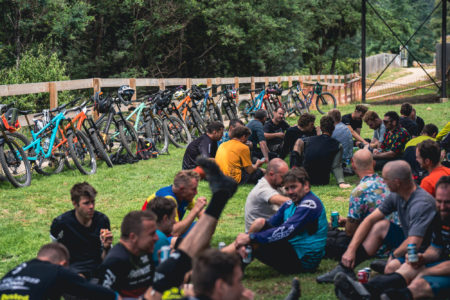Oli races the Trans Tas
I remember reading a Dirt Magazine article about multi-day enduros at least a decade ago. I liked the idea of a multi-day gravity race. Still, at the time, they were primarily held in galaxies far, far away, in a language I didn’t speak, by riders wearing skin suits with built-in armour and helmets with flip-down visors. Not being the owner of a millennium falcon and with my trusty translator C3P0 still on secondment with the Rebel Alliance, I put that idea on the proverbial back burner, where it stayed for many years.
I never imagined that such an event would appear on my back doorstep, making it possible for me, and all my mates, to go: no two-grand airfare, jetlag, travel insurance or covid restrictions. Just the smell of eucalyptus and long Tassie summer evenings to soak in after a good day’s ride.


Enter the Trans Tas
The Trans Tas is the third event brought to life in the Trans Enduro Series by Megan Rose, an avid mountain biker with formal training in event management. The enduro series came to fruition in 2015 with the Trans NZ, adding the Trans BC in 2016, and as of this year, the Trans Tas finally became a reality to make it three.
In relation to the other two events, the Trans Tas sits between them in terms of difficulty. I like to think of it as the cream in the middle of the TransEnduro lamington sponge.
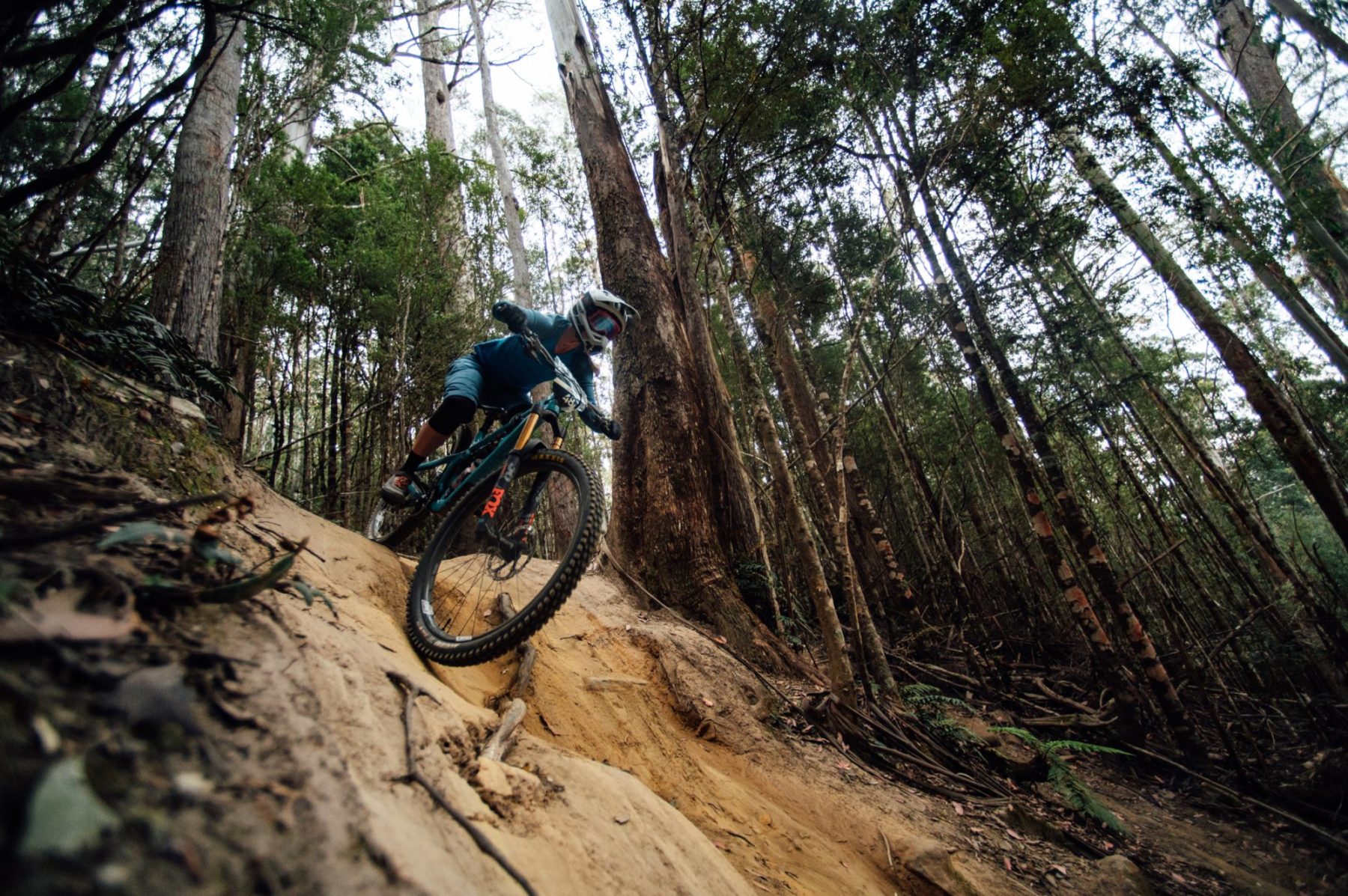
Spanning across five days, the Trans Tas has 23-stages, incorporating trails from three different locations in Tasmania; Maydena, Queenstown, and Derby. We completed 7000-ish metres of descending with a cumulative “race” time between two and three hours for most participants.
Put it another way, the event’s vibe is like taking an epic weekend ride with your mates and strapping a timing chip to your wrist for good measure. Take that and multiply it by five days, on the best trails in Tasmania, and add in full catering and transfers — there is also a dirtbag option available for those that want to keep the price down and self-cater food and accommodation.
Go as hard or mellow as you want; the clock doesn’t lie. But, more importantly, it provides a cold measure of your performance for speculation of what could have been, leading to inevitable animated discussions in liaison stages and over your après drink of choice.



Sound good? How do you know if this event is for you?
The primary provision of doing a Trans Series event is being honest about your riding ability and fitness. You’ll need to be comfortable riding black, and double black trails, blind — don’t expect any warm-ups or sighting runs.
Don’t get me wrong, there is ample time (and food) provided each day to get you through the stages, but you need to be confident riding technical trails for hours on end, day after day, regardless of the conditions. We experienced 35-degree heat in Maydena, and my thermometer bottomed out at a chilly six degrees in Queenstown. I don’t imagine it would be much fun for people that are in over their heads.

The skill and fitness required to survive the event create a degree of exclusivity. Combined with dual Covid related postponements and the event only being open to domestic riders, a giggling gaggle of 80 gravity gurus still made the pilgrimage.
Although those numbers are lower than Megan planned, I predict future iterations of this event will sell out, particularly as borders open to internationals. I also think the ride will become more accessible to domestic riders as rapidly developing mountain bike infrastructure and the sport’s popularity drive up the skill level and experience over the coming years.

Become a volunteer
Confidence is key in approaching an event like Trans Tas, and if you’re not totally sure of your ability to ride EWS level trails at race pace, sight unseen, there is a way for you to participate — be a race volunteer.
The race volunteers are essentially what makes Trans Tas possible; they are your course marshalls, the folks getting you to and from the trails, the smiling faces at the aid stations and the on-course medics — you’ll need a relevant qualification for that last one.


As a race volunteer, you get to ride the courses — as many or as few stages as you fancy —and experience first-hand what a multi-day enduro is like, albeit at a slightly downtempo pace. Of course, you have a job to do each day, but you’re amongst it; you see the stoke on everyone’s faces and hear the war stories at the end of the day — you may even have a few of your own.
It makes an event that has a high bar to entry accessible to a whole new stable of riders and allows them to immerse themselves in the environment the Trans Tas creates.
Plus, everything is comped. So all you have to do is make your way to the event, and your transfers, accommodation, meals, snacks and beers are all covered in exchange for your hard work — not a bad all-expenses-paid holiday if you ask me.
At this year’s Trans Tas, a number of the volunteers were partners of the racers — including my partner Sar — which meant that we could share and enjoy the experience together.
What does it offer over and above regular enduro racing?
With the event spanning the better part of a week, rather than squishing everyone into a more formal race format, Trans Tas is designed to have a casual, inclusive and social vibe. We’re all here for a good time, right?
The casual vibe starts during the registration process, where each entrant nominates with whom they want to ride and share accommodation.
Once on course, riders are loosely divided into waves consisting of groups of friends that self organise at the top of each timed stage. With no prescribed starting order, there is no need to track the time too closely or stress if you need to stop and fix a mechanical. Instead, riders naturally space themselves out and drop into each stage when ready as each day unfolds.

It was a dynamic process where I could jump behind someone faster than me, giving just enough time for the dust to settle. Or I would negotiate a full minute gap with the stage marshal before dropping in behind someone I knew was slower than me to avoid unnecessary passing manoeuvres.
I would often see riders dropping in pairs, with one inviting the other to follow their line or party trains of five-plus people — usually, friends who had ordered themselves just like they were chasing each other down on their local trails.
This means maximum fun times with your mates both on and off the course. With only five(ish) hours of riding per day, there is still plenty of time to mingle with everyone and make new friends at the après — especially in the excellent venues that we got to frequent each afternoon across the three locations.
The only difference is you have a race plate in the shape of Tasmania with whatever name you choose.

Riding those places blind? You’re kidding, right?
The race takes on some of the most challenging trails across Tasmania, and I have to admit, I was a little nervous about racing these trails blind. I had been to Maydena and Derby once before, so I knew what the terrain was like, but I hadn’t committed any of the trails to memory. Queenstown was still an unknown entity.

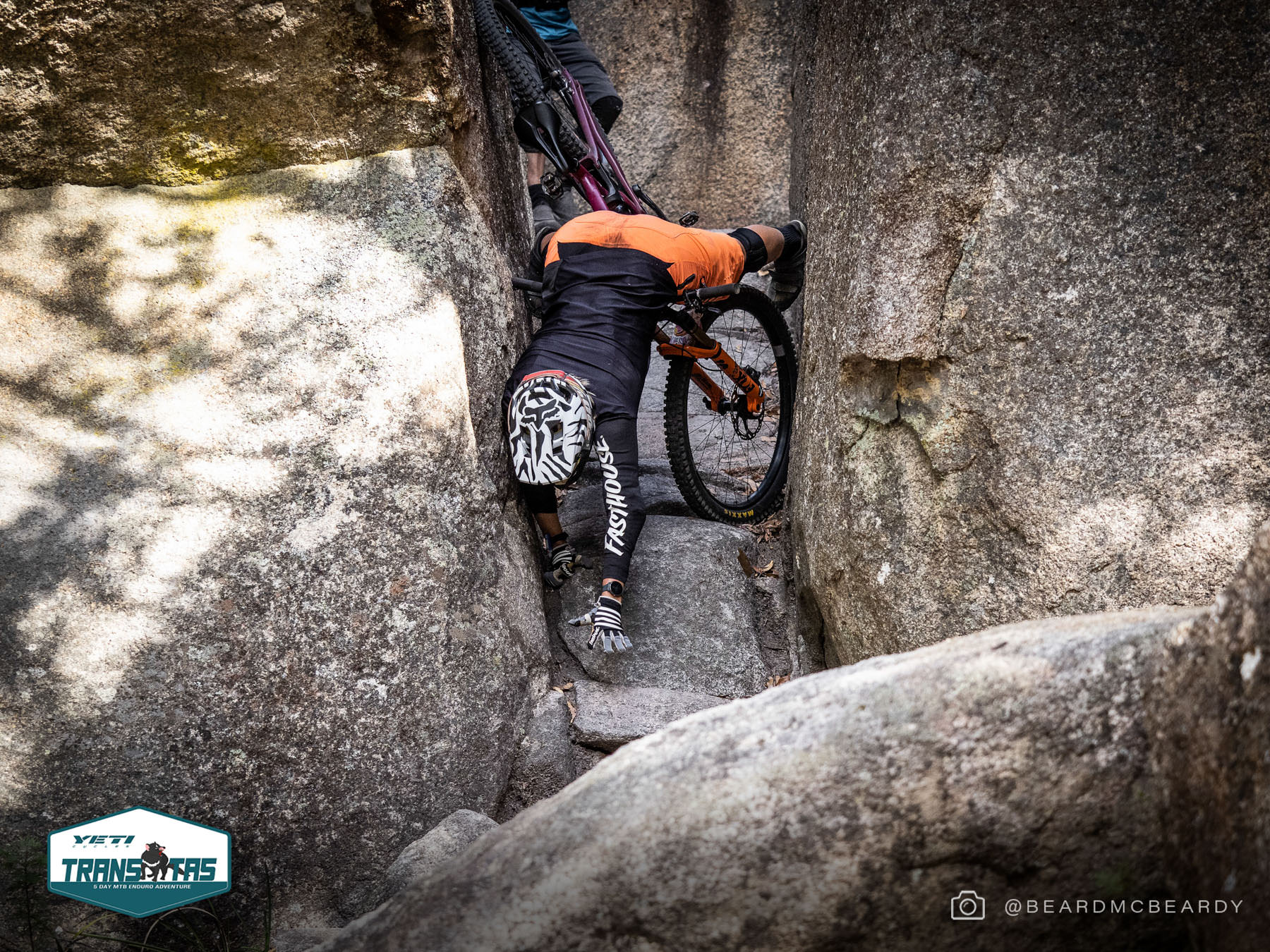
Further to that, at the rider briefing the night before the event, Megan gave us the pep talk about staying safe, which I’ll now paraphrase;
“We find that we get fewer injuries if we don’t tell people to ride within their limits, and instead to just go for it. So, we encourage you all to SEND IT!”
The gauntlet had been laid. Now the challenge was how could I balance the speed with staying upright?
Zen and the art of blind racing
Blind racing creates the opportunity to test oneself on terrain that isn’t committed to memory. The challenge essentially boils down to being able to ride as fast as possible within one’s limits. My mind drifted back to my motorcycle learners, where we had the following drilled into us, “if you can’t stop in the distance you can see ahead, you are going too fast.”
The trails we rode have been designed and built with predictability as a critical principle so riders can have a safe and exhilarating experience right from the first pedal stroke. That anecdote above is a good starting point. However, I modified it to “if I can’t slow down enough not to get hurt in the distance I can see ahead, I am going too fast” — this was my mantra for the week.
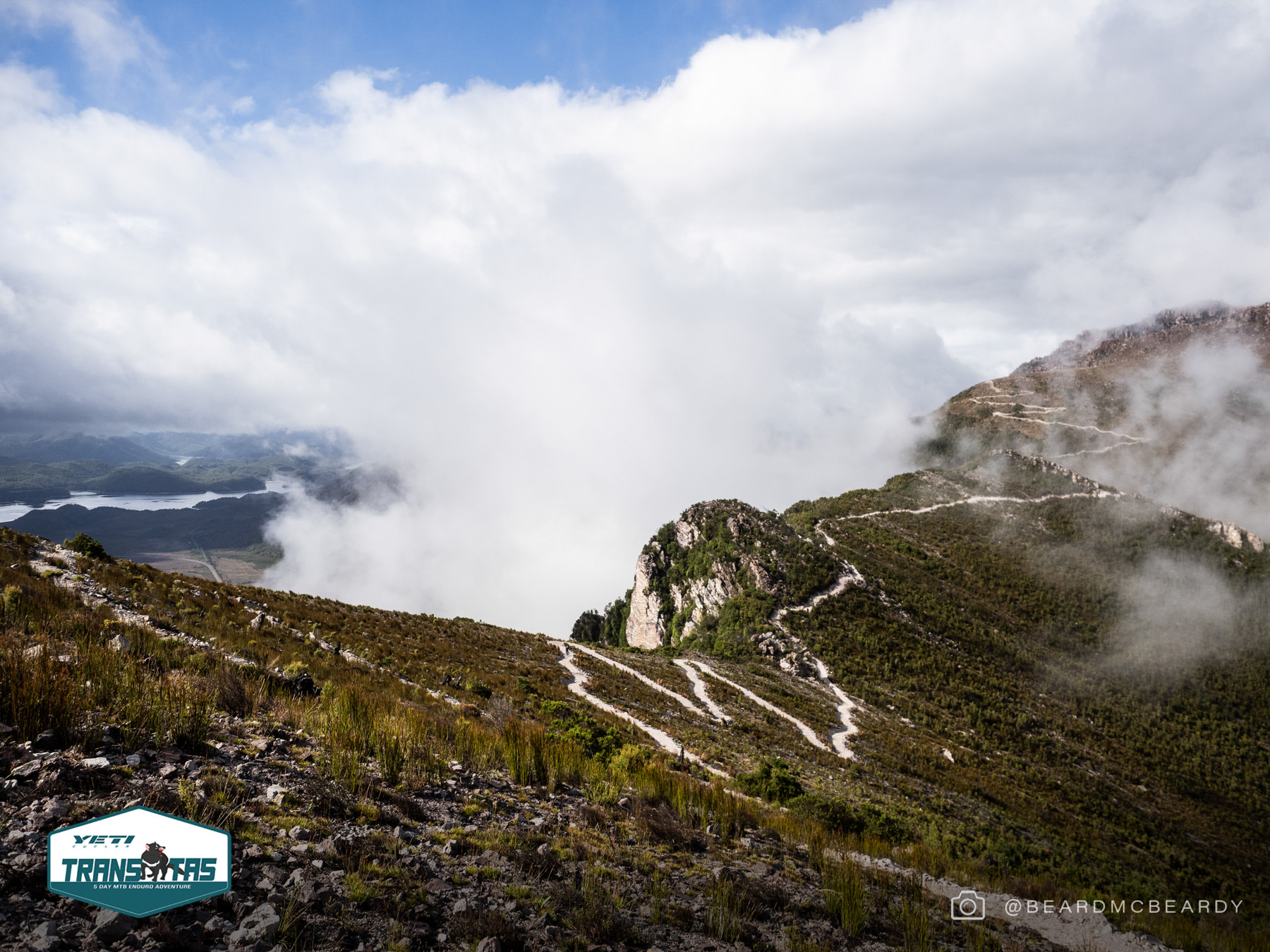

The key to blind racing is less about taking risks and more about learning terrain processing at speed, consistent breathing and staying focussed on what’s ahead. It’s a meditation of sorts, a synergy of mindfulness and trust. A relaxed rider can spend most of their time processing the “next” while letting the “now” flow under their wheels, like sand through the hourglass, water off a duck’s back, or any other preferred and appropriate cliché you might favour.
This is something anyone can practice on their home trails even if they know them well. An increased capacity to trust oneself and look ahead is easier to develop on familiar terrain. In addition, it can significantly decrease physical effort and improve flow, which directly translates to a more satisfying and zen-like experience.

Math-letics: riding as fast as I could, on trails I didn’t know, without crashing
Sam Hill has an infamous quote from back in the day that goes something like, “sometimes you have to slow down to go faster.”
I followed this wisdom while scribbling out some back of the envelope calculations that helped contain my excitement and hold it together. I reasoned with myself the following:
- Any mistake causing me to veer offline, brake excessively or come to a near stop was worth 5 seconds.
- Any crash where I came off was worth at least 10 seconds.
- On a long descent where I didn’t know the track and inadvertently crossed into the land of “overfroth,” I knew that two mistakes and a crash could happen on any given run.
Extrapolating this to 23 stages, I figured I had the potential to lose 20 seconds per 5-8min run, that when added together, could cost me seven-and-a-half minutes, or 20 places in the overall standings, or a quarter of the field.
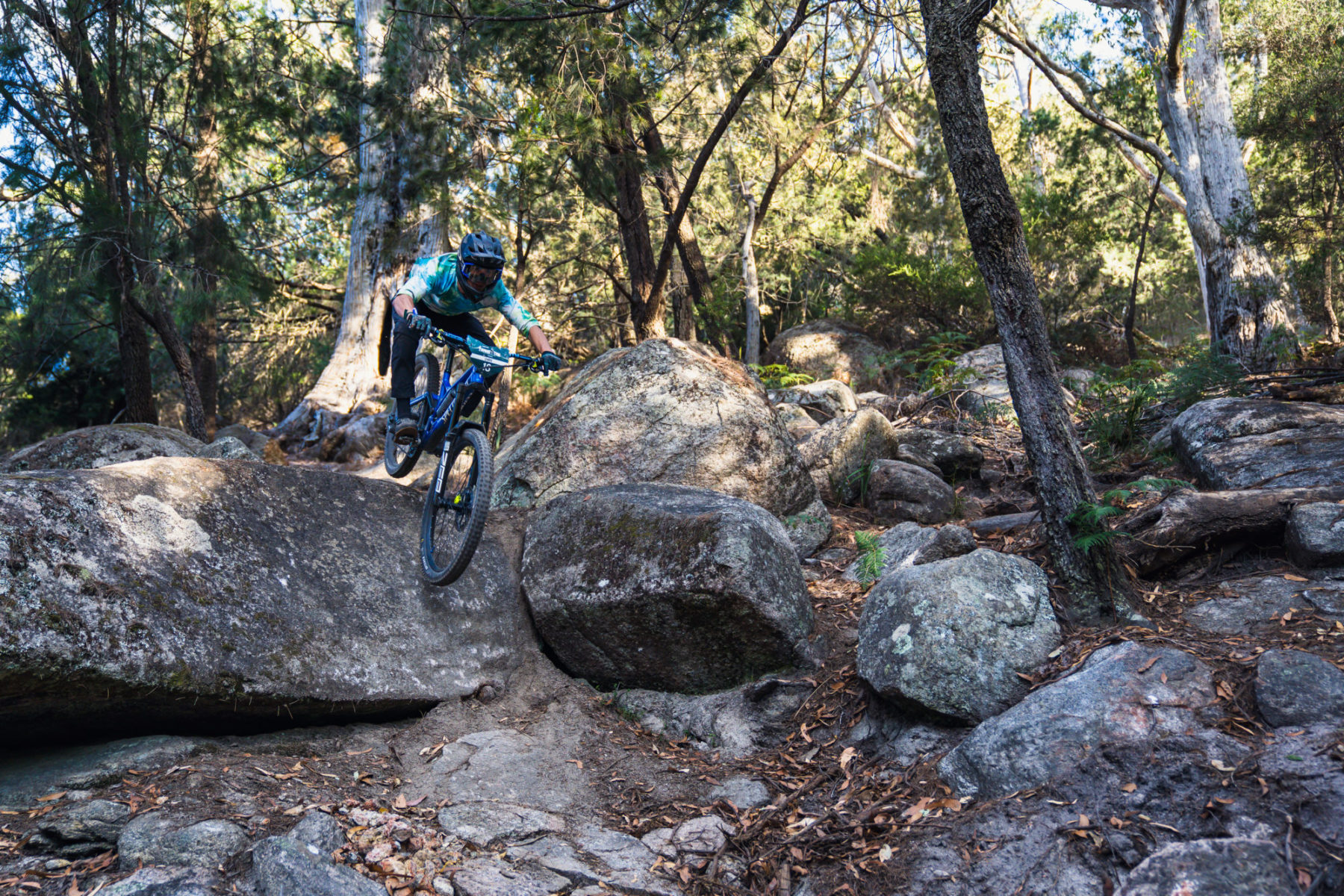
So the philosophy that I took into this was relative restraint rather than reckless abandon.
This was a chance to ride within my means, get into a flow, conserve momentum and carry speed in unfamiliar terrain. I reminded myself that several World Cup podiums had been achieved with no chain. There is a lot to be said for developing skills beyond late braking into corners and dropping watt bombs, trying to get back up to speed if you overcook it.
At the end of each run, I felt pretty satisfied that I had held it together. I could focus on what I did right, rather than the usual list of excuses — blew that corner, came in too hot to make the section here, ran off track there because I didn’t look far enough ahead, didn’t see the brown snake early enough to do a bunnyhop etc.


Anyway, that was my strategy, and it worked pretty well. I made three mistakes in total and ran off the track once over the whole event. Sure I could have pushed a bit harder, but it was nice to fly home with bike and body in one piece.
The final thing I have to say about the mental approach to this kind of event is that it doesn’t matter if you can hit a jump or tackle a steep line. Getting into a flow state is a challenge all skill levels of riders can take on to improve their experience.
Trans Tas 2023, we’ll be back
So there you have it. The inaugural Trans Tas race is done and dusted! We did it despite all the Covid setbacks and the fact that it was impossible to source any tire with both a desirable tread pattern and a sidewall suited to the gnarly terrain.
Hats off to Megan and her merry band of volunteers and all the venues and local businesses that enabled the Trans Tas to go ahead.

Trans Tas will only continue to improve, and you can bet they will be heading back next year. The 2023 dates haven’t been announced just yet, but we expect the race will run in a similar period just after the Christmas school holidays have wrapped up.For more information, head over to the Trans Tas website.
Photos: Kristina Vackova /@kiphotomedia, Marcus Enno / @beardmcbeardy, Charlie Rex Edis / @charlierexphoto, Simon Holmes / @bigshedstudios






















